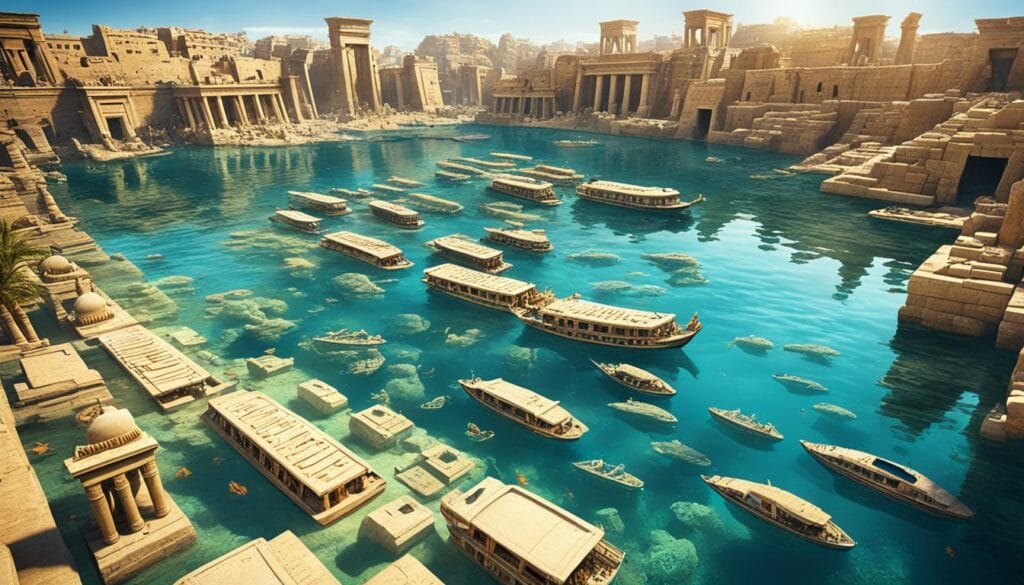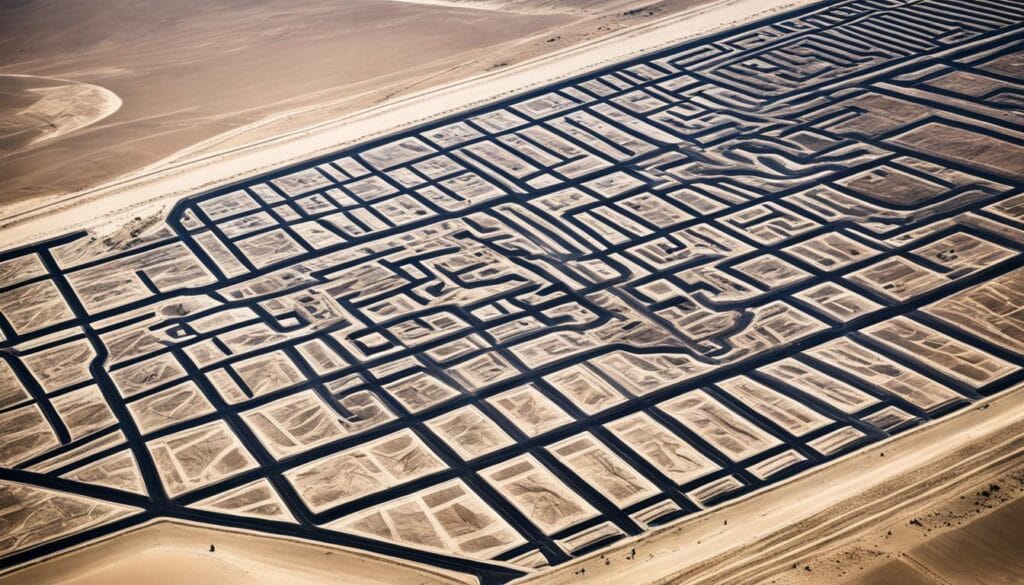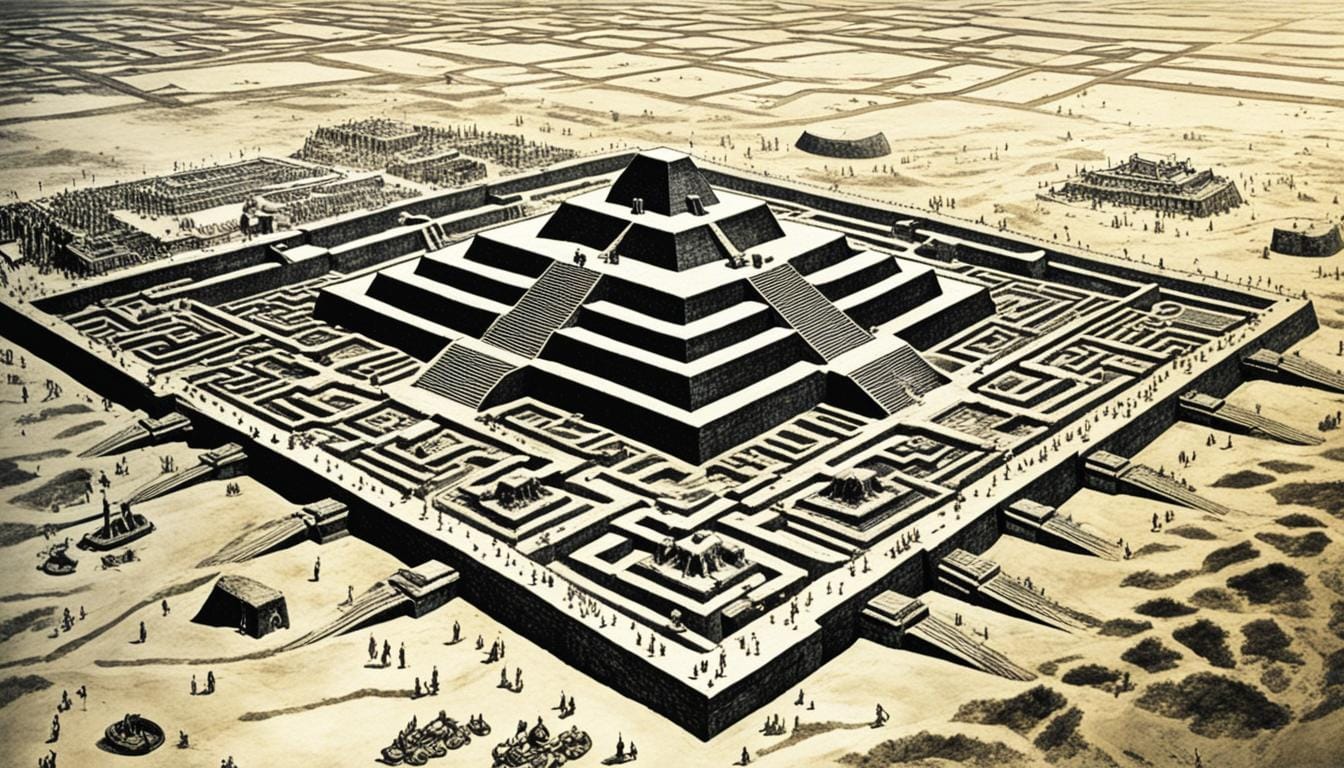Ancient history is full of mysteries that still puzzle us today. From lost burial sites to sunken cities, these mysteries have caught our attention for centuries. Archaeologists are always digging into the past, looking for answers to big questions.
They use new technologies to uncover more questions than answers. This article will look at 10 of the most baffling mysteries from the ancient world. Each one is a window into a time long past.
Thonis-Heracleion: The Real-Life Atlantis
Under the Mediterranean Sea, an ancient Egyptian port city named Thonis-Heracleion has been found again. It was a bustling commercial center that vanished over time. Now, marine archaeologists have brought it back to life since the early 2000s.
Rediscovering an Ancient Egyptian Port City
Thonis-Heracleion was a key trading spot in the 6th-4th centuries BC, near Alexandria. It thrived until the 2nd century BC, then slowly faded away. Earthquakes, tsunamis, and rising sea levels led to its downfall. By the 8th century AD, it was gone, hidden under the sea for over 1,200 years.
Artifacts Revealing Secrets of a Lost Civilization
- Massive statues, animal sarcophagi, and temple ruins have been recovered from the underwater site.
- Archaeologists have also found pottery shards, jewelry, coins, and even 2,400-year-old fruit baskets, offering a glimpse into the daily life and trade activities of this rediscovered lost city.
- The findings from the underwater archaeological finds have shed new light on the cultural and religious practices of this ancient civilization.

Thonis-Heracleion, often called the “real-life Atlantis,” has caught the public’s attention. It has led to more research into this ancient Egyptian port city. As more artifacts are found, the story of this lost civilization keeps unfolding. It shows the richness and complexity of the past.
The Plain of Jars: Megalithic Mystery in Laos
In northern Laos, the Plain of Jars is a mysterious site. It’s filled with thousands of megalithic stone jars. These jars, some over 10 feet tall and weighing tons, have puzzled experts for years. They are Iron Age artifacts found at an ancient funerary site that is still not fully understood.
Legend says giants used the Plain of Jars as wine glasses. But most think they were funeral urns. The jars are very old, dating back to 1240 B.C. Yet, their true purpose and how they were made are still unknown.
Studying the Plain of Jars is hard because many jars are near unexploded bombs from the Vietnam War. This danger stops thorough research. So, much about the site and its culture remains a mystery.
| Jar Site Statistic | Measurement |
|---|---|
| Jar Sites Identified | Over 90 in Xiangkhouang Province |
| Jars per Site | 1 to 400 |
| Jar Height and Diameter | 1 m to 3 m |
| Jar Material | Sandstone, granite, conglomerate, limestone, breccia |
| Jar Age | 1240 to 660 BC |
Researchers keep trying to solve the mysteries of the Plain of Jars. They hope to learn about the ancient people who made these huge stones. As they learn more, the Plain of Jars could teach us a lot about Laos’s history and the creativity of its ancient people.

Guanabara Bay: Evidence of Roman Presence in Brazil?
In Brazil’s Guanabara Bay, near Rio de Janeiro, a big find has caused a lot of talk among historians and archaeologists. In 1982, Robert Marx, a famous shipwreck explorer, said he found Roman vases, called amphoras, under the water. He believed these vases showed the Romans came to Brazil a thousand years before the Portuguese.
But, many experts doubt Marx’s story. The Brazilian government stopped him from exploring further, worried about looting and changing history. Marx then said the navy was hiding the proof by dumping sediment on the vases.
The Controversial Claims of Robert Marx
Robert Marx is a well-known but divisive name in underwater archaeology. He believes ancient sailors, including the Romans, reached the Americas before Christopher Columbus. His finding of the Guanabara Bay amphoras was evidence he shared to support this idea.
Debate Over Pre-Columbian European Contact
The mystery of Guanabara Bay has sparked a big debate about early European contact with the Americas. Some experts question Marx’s claims, but others see signs that ancient sailors might have traveled across the Atlantic more often than we thought.
The debate over the Guanabara Bay artifacts is ongoing. Whether the Romans were in Brazil is still not proven. The mystery keeps drawing people into the search for ancient history.

The Nazca Lines: Gigantic Geoglyphs in Peru
About 2,000 years ago, a pre-Inca civilization made huge Nazca Lines, or Peruvian geoglyphs, in Peru’s dry coastal plain. These ancient ground drawings were hidden until planes flew over in the 1930s. Now, over 1,000 designs are found, including long lines, shapes, and animal pictures.
In 2022, 168 newly discovered Nazca Line figures were found. But, we still don’t know why they were made. Some think they were for water rituals. The Nazca Lines cover 170 square miles in Peru’s Nazca Desert. They date back to between 200 B.C. and A.D. 500, with the oldest ones made around 500 B.C.
Uncovering the Purpose of the Nazca Drawings
There are thousands of Nazca Lines showing animals and plants. The first big study was by Peruvian archaeologist Toribio Mejia Xesspe in 1927. The 1930s brought more attention as more planes flew over the area.
Many theories exist about the Nazca Lines. Some say they match constellations, others think they were for pilgrimages or water rituals. With over 800 straight lines, 300 shapes, and 70 animal and plant designs, they still puzzle and amaze us.

The Paracas Candelabra: Peru’s Enigmatic Geoglyph
The Paracas Candelabra sits on the northern side of the Paracas Peninsula in Peru. It’s a huge geoglyph that has caught the eye of many researchers and travelers. It stretches 595 feet high and can be seen from 12 miles out at sea. This makes it a possible ancient navigation tool for sailors.
The Paracas culture made this symbol between 800 BCE and 400 CE. Archaeologists found pottery in the area that dates back to around 200 BCE. This suggests the geoglyph might have been made then. Some think it shows a sacred plant, like the Jimson weed. Others believe it could be a picture of the creator god’s trident.
Despite its size and importance, we still don’t know why the Paracas Candelabra was made. But its location by the coast might mean it helped sailors cross the Pacific Ocean. It could also have guided them by matching up with stars or constellations.
In 2016, the Peruvian government made the Paracas Candelabra a national heritage site. This means anyone harming it faces serious consequences. As scientists learn more about this Peruvian geoglyph, it shows the creativity and culture of ancient people.
Sacsayhuamán: Inca Engineering Marvel
Outside Cuzco, Peru, lies the fortress of Sacsayhuamán. It shows the Inca’s amazing engineering skills. Built in the 15th century, it’s a masterpiece with huge stone blocks, some as heavy as 125 tons. These stones fit together perfectly, without mortar.
Inca workers used bronze and stone tools to move and place these huge stones. They built walls that have lasted through time and many earthquakes. Today, experts are amazed by how the Incas did this incredible work.
Massive Stonework Defying Modern Construction
The main wall of Sacsayhuamán has blocks as tall as 5 meters and wide as 2.5 meters. These blocks weigh between 90 and 125 tons. The work here shows the Inca’s amazing engineering skills and their ability to make buildings that can withstand earthquakes.
This fortress covers over 3,000 hectares on a hill, showing the Inca’s military and administrative power. Its location, design, and construction amaze visitors and researchers. They are left in awe of the Inca’s engineering skills.
Sacsayhuamán is a lasting example of Inca engineering marvel. It shows the Inca’s deep knowledge of ancient construction techniques. They could make earthquake-resistant structures from massive stone blocks. The site is still studied and admired, showing the Inca’s amazing engineering skills.
Mysteries of Ancient Civilizations
Unexplained Phenomena from the Ancient World
The ancient world is full of mysteries. Many archaeological sites and artifacts still puzzle experts today. The Nazca Lines in Peru and the underwater ruins off Japan’s coast are just a few examples. They give us a peek into what our ancestors could do and think.
The Mayan “Long Count” calendar is a big mystery. Some thought it predicted the end of the world in 2012. But its true meaning is still unknown. It shows the Mayans knew a lot about the stars.
The Neolithic standing stones at Carnac in France are another puzzle. There are over 10,000 of them. They show incredible engineering and organization skills of ancient people.
In the Amazon, the Incan civilization is another mystery. They lived without money or gold, thanks to their environment. But, the Spanish conquest and smallpox killed 90% of the Inca people quickly.
From the underwater ruins off Okinawa to the lost city in the waters off Cuba, the ancient world still has many secrets. These unexplained phenomena make us rethink what we know about ancient civilizations.
| Unexplained Phenomenon | Location | Estimated Age |
|---|---|---|
| Nazca Lines | Peru | 200 B.C. to A.D. 600 |
| Mayan “Long Count” Calendar | Mesoamerica | Began in 3114 B.C. |
| Neolithic Standing Stones at Carnac | France | 2100-1500 B.C. |
| Submerged Ruins off Okinawa | Japan | Unknown |
| Potential Lost City off Cuba | Cuba | Unknown |
Cleopatra’s Lost Tomb: Where is She Buried?
The final resting place of Cleopatra VII, the last pharaoh of ancient Egypt, is a mystery. Historians and archaeologists have searched for it for years. They know a lot about her life and death, but where she was buried is still unknown.
Cleopatra’s tomb was thought to be in Alexandria, her city. But a big tsunami in 365 AD might have destroyed it. Some think it could be in the Nile Delta, in a temple for Isis and Osiris. The story of her and Mark Antony’s joint burial adds to the mystery.
Zahi Hawass and Kathleen Martinez have spent years looking for Cleopatra’s tomb. New technology like ground-penetrating radar and LiDAR has helped their search. Recent finds at the temple of Taposiris Magna have brought new hope.
Finding Cleopatra’s tomb is a big deal for archaeologists and history lovers. It could tell us more about her life and the end of ancient Egyptian civilization. Everyone is excited to see what they might discover next.
The Voynich Manuscript: An Undeciphered Codex
In 1912, Wilfrid Voynich bought a mysterious medieval book. It had strange pictures and a language that scholars couldn’t figure out. This book, now called the Voynich Manuscript, has been a mystery for over a hundred years.
This book from the 15th century has about 30 unique characters. It’s split into six parts, each with its own special words. You’ll find topics like medicine, recipes, and astronomy. The pictures are just as strange, showing plants turning into organs or faces, and weird designs.
Attempts to Crack the Code of an Enigmatic Text
Many people have tried to understand the Voynich Manuscript over the years. Famous names like Alan Turing and the FBI have given it a go. But no one has been able to figure it out yet.
Some think it’s just a trick, while others believe it might hold deep, old secrets. Researchers think it could be an ancient language, but not everyone agrees. The Voynich Manuscript keeps its secrets well.
Now at Yale University, the Voynich Manuscript is a symbol of ancient mysteries. Its pages are full of secrets waiting to be discovered. Scholars and fans are still trying to unlock its secrets.
The Yonaguni Monument: Japan’s Underwater Pyramid
Off the coast of Yonaguni Island in Japan, there’s an underwater rock formation called the Yonaguni Monument. It was found in the 1980s and looks like a step pyramid. It’s at least 165 feet long, 65 feet wide, and 25 meters tall.
This has made people argue about what it is. Is it just a natural rock or could it be from an ancient underwater city?
Natural Formation or Man-Made Structure?
Many have wondered where the Yonaguni Monument came from. Some think it looks like ancient buildings, like pyramids or castles. They believe it could be from a lost city or an old culture called Yamatai.
But, others say it’s just a natural rock shape, made by the ocean over millions of years. They think it’s the result of erosion and tectonic activity.
The Yonaguni Monument is under 26 meters of water, near Taiwan. It’s thought to be anywhere from 10,000 to 2,000-3,000 years old. In 1986, some scientists thought it was made by humans. But a study in 2019 said it’s a natural rock.
People are still arguing about where the Yonaguni Monument came from. Some believe it’s a sign of an ancient city because of its shape. Others think it’s just a weird rock.
Either way, the Yonaguni Monument is a mystery that interests scientists and the public. It’s a fascinating underwater site.
Stonehenge: Eternal Enigma of the Stone Age
Stonehenge is a famous prehistoric landmark that shows the skill and will of our ancestors. It started over 5,000 years ago, long before England used bronze. Despite being studied for centuries, many of its secrets are still hidden. These secrets might be about its religious, ceremonial, astronomical, and therapeutic uses.
The smaller stones at Stonehenge came from Wales, over 150 miles away. The big stones, weighing about 25 tons each, came from nearby Marlborough Downs. Building Stonehenge was a complex task. It has a big circle of stones and a horseshoe shape inside, showing amazing engineering skills.
Stonehenge might have been a place to watch the stars. It lines up with important astronomical events like solstices and equinoxes. This suggests it could have been used for tracking the sky or celebrating special times. People still visit Stonehenge for events like the summer solstice to see the sun align with the stones.
Keeping Stonehenge safe for the future is very important. There are efforts to stop erosion and damage. Even with many questions still, Stonehenge shows the amazing skills of our ancient ancestors. They moved and placed these huge stones with great precision and skill.
| Fact | Details |
|---|---|
| Construction Timeline | Stonehenge was built around 2480 BC, during the Neolithic period, long before England entered the Bronze Age. |
| Stone Transport | The smaller bluestones at Stonehenge were transported nearly 150 miles from the Preseli Hills in Wales, while the massive sarsen stones, each weighing around 25 tons, were brought from Marlborough Downs, located around 20 miles away. |
| Astronomical Significance | Stonehenge’s alignment with key astronomical events, such as solstices and equinoxes, hints at its possible use as a celestial observatory or for marking significant calendar moments. |
| Cultural Traditions | Visitors still flock to Stonehenge during events like the summer solstice, where the alignment of the stones with the sun can be witnessed and celebrated. |
| Preservation Efforts | Stonehenge is the subject of preservation efforts to protect the monument from erosion and other forms of deterioration, ensuring its survival for future generations. |
Forbidden History and Esoteric Knowledge
The secrets of old civilizations go beyond just old ruins and artifacts. Many believe that the old folks had advanced knowledge and tech that we don’t know about today. They used mystical ways and hidden texts. This idea of secret wisdom from our ancestors still grabs our attention.
Looking into these mysterious parts of history gives us a peek into the unknown. It makes us wonder about the advanced knowledge humanity might have had.
Ancient Wisdom Concealed from the Modern World
Many think the ancient Egyptians and Mayans had tech and knowledge that challenge our history. They were masters of astronomy and calendars, showing a sophistication we can’t fully understand. They might have known about things like crustal shifts and how stars affected their societies.
There are also whispers of forbidden texts and secret teachings kept from us. The idea of a hidden, sacred knowledge has always intrigued those who love mysteries. It makes us think about what we might have missed in history.


